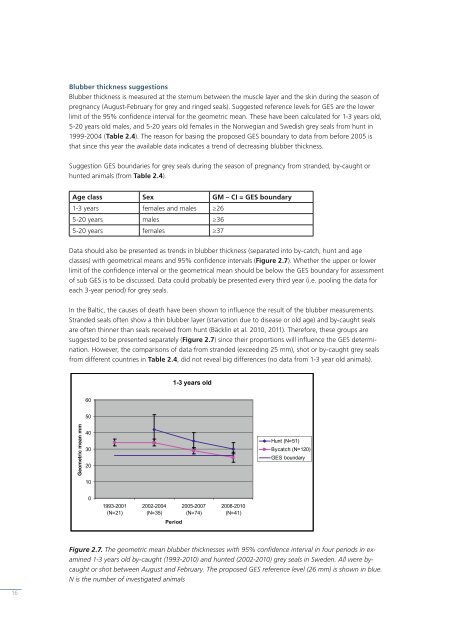Interim report of the HELCOM CORESET project
Interim report of the HELCOM CORESET project
Interim report of the HELCOM CORESET project
You also want an ePaper? Increase the reach of your titles
YUMPU automatically turns print PDFs into web optimized ePapers that Google loves.
16<br />
Blubber thickness suggestions<br />
Blubber thickness is measured at <strong>the</strong> sternum between <strong>the</strong> muscle layer and <strong>the</strong> skin during <strong>the</strong> season <strong>of</strong><br />
pregnancy (August-February for grey and ringed seals). Suggested reference levels for GES are <strong>the</strong> lower<br />
limit <strong>of</strong> <strong>the</strong> 95% confi dence interval for <strong>the</strong> geometric mean. These have been calculated for 1-3 years old,<br />
5-20 years old males, and 5-20 years old females in <strong>the</strong> Norwegian and Swedish grey seals from hunt in<br />
1999-2004 (Table 2.4). The reason for basing <strong>the</strong> proposed GES boundary to data from before 2005 is<br />
that since this year <strong>the</strong> available data indicates a trend <strong>of</strong> decreasing blubber thickness.<br />
Suggestion GES boundaries for grey seals during <strong>the</strong> season <strong>of</strong> pregnancy from stranded, by-caught or<br />
hunted animals (from Table 2.4).<br />
Age class Sex GM – CI = GES boundary<br />
1-3 years females and males ≥26<br />
5-20 years males ≥36<br />
5-20 years females ≥37<br />
Data should also be presented as trends in blubber thickness (separated into by-catch, hunt and age<br />
classes) with geometrical means and 95% confi dence intervals (Figure 2.7). Whe<strong>the</strong>r <strong>the</strong> upper or lower<br />
limit <strong>of</strong> <strong>the</strong> confi dence interval or <strong>the</strong> geometrical mean should be below <strong>the</strong> GES boundary for assessment<br />
<strong>of</strong> sub GES is to be discussed. Data could probably be presented every third year (i.e. pooling <strong>the</strong> data for<br />
each 3-year period) for grey seals.<br />
In <strong>the</strong> Baltic, <strong>the</strong> causes <strong>of</strong> death have been shown to infl uence <strong>the</strong> result <strong>of</strong> <strong>the</strong> blubber measurements.<br />
Stranded seals <strong>of</strong>ten show a thin blubber layer (starvation due to disease or old age) and by-caught seals<br />
are <strong>of</strong>ten thinner than seals received from hunt (Bäcklin et al. 2010, 2011). Therefore, <strong>the</strong>se groups are<br />
suggested to be presented separately (Figure 2.7) since <strong>the</strong>ir proportions will infl uence <strong>the</strong> GES determination.<br />
However, <strong>the</strong> comparisons <strong>of</strong> data from stranded (exceeding 25 mm), shot or by-caught grey seals<br />
from different countries in Table 2.4, did not reveal big differences (no data from 1-3 year old animals).<br />
Geometric mean mm<br />
60<br />
50<br />
40<br />
30<br />
20<br />
10<br />
0<br />
1993-2001<br />
(N=21)<br />
2002-2004<br />
(N=35)<br />
1-3 years old<br />
Period<br />
2005-2007<br />
(N=74)<br />
2008-2010<br />
(N=41)<br />
Hunt (N=51)<br />
Bycatch (N=120)<br />
GES boundary<br />
Figure 2.7. The geometric mean blubber thicknesses with 95% confi dence interval in four periods in examined<br />
1-3 years old by-caught (1993-2010) and hunted (2002-2010) grey seals in Sweden. All were bycaught<br />
or shot between August and February. The proposed GES reference level (26 mm) is shown in blue.<br />
N is <strong>the</strong> number <strong>of</strong> investigated animals













